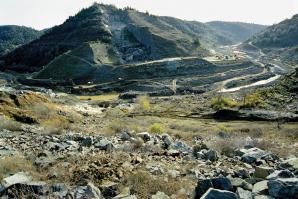California’s water supply largely depends on the capacity of dams, reservoirs and pipelines built in the past century. These days, however, water utilities are increasingly using conservation and efficiency measures to manage supplies. While conservation and efficiency can have different meanings, they are often used interchangeably and refer to accomplishing the same tasks with less water. According to Washington-based American Rivers, conservation means changing behavior in order to save water, such as taking shorter showers, while efficiency refers to infrastructure investments, such as fixing leaky pipes or installing water-saving equipment.
Compared to building dams, water efficiency projects require less time, money and planning. While some water experts say efficiency and conservation options should be exhausted before pursuing dams, others argue California needs all possible water management strategies at its disposal to create a sustainable system.
Asking whether efficiency is more feasible than building dams is a traditional way of framing the issue but presents a “false choice,” says Mark Cowin, California Department of Water Resources’ deputy director for integrated water management. “We believe firmly that there’s no silver bullet, no single answer to California’s water problems,” he says. “We can’t rely upon new dams. We can’t rely upon water conservation alone, but we need to take a more portfolio approach to water management.”
The state’s water system serves a collection of regions with different needs. Although efficiency projects are less expensive than building dams, dams do more than store water. They provide operational flexibility, allowing water managers to move large amounts of water quickly, Cowin says. They also provide flood control, recreation and — with their ability to release large amounts of cold water at the right time — help protect fish. The belief that efficiency is better because it’s cheaper promotes gridlock in shaping California water policy, he says.
Valerie Nera, policy advocate for the California Chamber of Commerce, says conservation and efficiency can’t accommodate population growth alone. The state Department of Finance projects California’s population will reach 49.2 million by 2030, up from 38.3 million today. And the state projects it will need an additional 2 million to 6 million acre-feet of water annually to meet statewide needs by then. Conservation and efficiency meet immediate water needs, but dams and reservoirs are needed for long-term supply, she says.
Mary Ann Dickinson, executive director of the Chicago-based nonprofit advocacy group Alliance for Water Efficiency, says water suppliers should exhaust conservation options before pursuing dams because they can reduce both short- and long-term demand. Denver and Boston lowered demand and created new water supplies through conservation and efficiency measures, she says, avoiding the need to build a dam and reservoir, respectively. Conservation saves money for the consumer and the utility, which has to pump and treat less water. It reduces energy needed to heat, treat and transport water, which in turn reduces greenhouse gas emissions. In California, 20 percent of electricity use comes from the energy needed to transport and treat water.
Last year, Congress asked the alliance to compile a list of water efficiency projects nationwide that could be funded with federal stimulus money. The study identified $2.5 billion in projects. California had at least 485 water efficiency projects, such as installing automatic water meters or replacing outdated toilets. Water agencies had submitted the projects for state bond funding.
Conservation measures cost a fraction of the price for a new dam yet can yield as much water, says Jenny Hoffner, director of American Rivers’ water supply program. Water efficiency and conservation are the cheapest, fastest and most reliable sources, she says. Water efficiency programs can cost from 46 cents to $250 per 1,000 gallons, Hoffner says, while water from dams can cost $4,000 per 1,000 gallons.
In 2003, the Pacific Institute, an Oakland-based think tank, released a study about California’s water conservation potential. Existing technology can save one-third of California’s current urban water use — more than 2.3 million acre-feet, according to the study, and at least 85 percent of this can be saved at costs below what it would cost to tap into new sources.
Water conservation and efficiency are the same as developing new supply, says Heather Cooley, a senior research associate at the institute. According to the study, developing supply through conservation and efficiency, including fixing leaks and installing water-efficient irrigation systems, would prevent the need to build water supply dams or reservoirs in California for at least 30 years.
“The idea is if we really manage our resources sustainably and manage demand,” Cooley says, “we have a tremendous potential to continue to have a vibrant economy, a robust agricultural sector and healthy environment.”
Recommended For You

Wall of Worry
The (almost) rise and fall of the Auburn dam
More than four decades after it was proposed, the Auburn dam still draws conflicting opinions about why it was doomed.

Change of Plans
Regional conservation efforts battle dwindling budgets and staff
The future of community growth in the Capital Region hinges on the fate of several habitat conservation plans slogging through the development pipeline.


